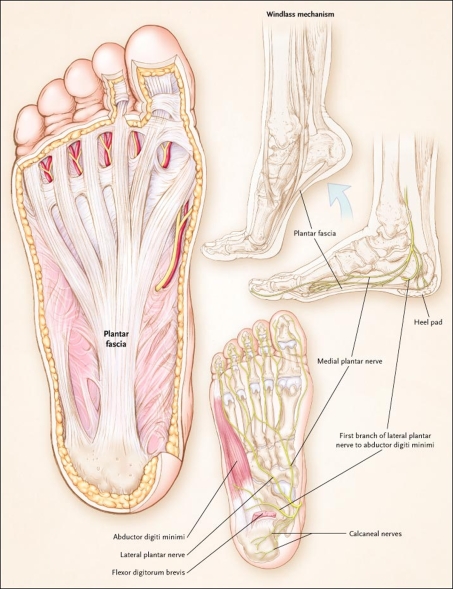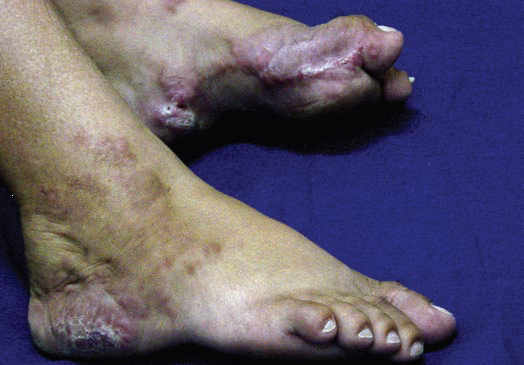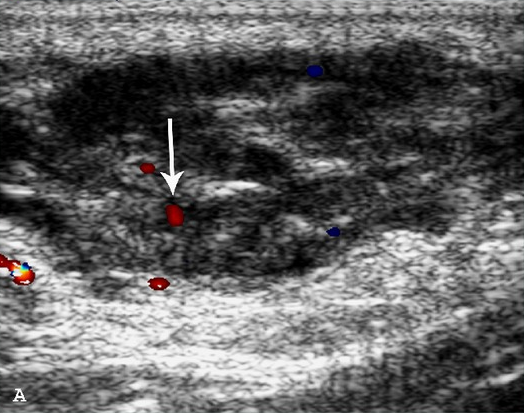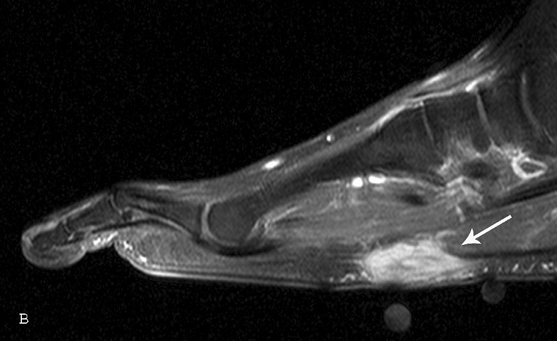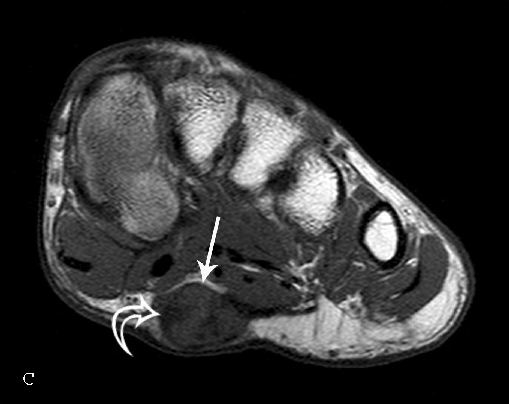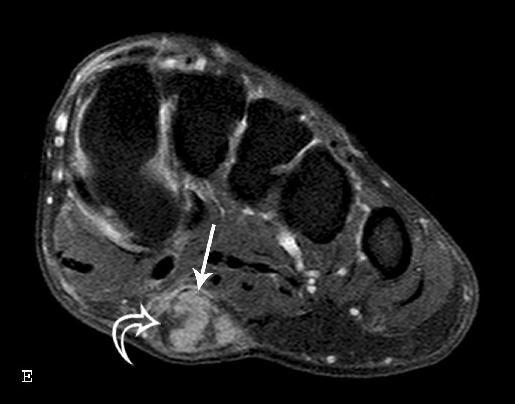Plantar Fibromatosis
Original Editor - Anja Vanroelen
Top Contributors - Anja Vanroelen, Laura Ritchie, Kirenga Bamurange Liliane, Admin, Kim Jackson, Lucinda hampton, 127.0.0.1, Evan Thomas and WikiSysop
Definition/Description[edit | edit source]
Ledderhose disease, also known as plantar fibromatosis or Morbus Ledderhose, is a (typically) small slow-growing thickening of the superficial fibromatoses which is actually a soft tissue tumor of the plantar aponeurosis similar in appearance to the disease which occurs in the palm of the hand (disease of Dupuytren). Basically it can be described as a benign fibroblastic proliferative disorder in which fibrous nodules may develop in the plantar aponeurosis, more specifically on the medial plantar side of the foot arch and on the forefoot region. The symptoms are swelling, pain is not usual and also a contraction is not applicable in the first stage. Cite error: Invalid <ref> tag; name cannot be a simple integer. Use a descriptive title Cite error: Invalid <ref> tag; name cannot be a simple integer. Use a descriptive title Cite error: Invalid <ref> tag; name cannot be a simple integer. Use a descriptive title Cite error: Invalid <ref> tag; name cannot be a simple integer. Use a descriptive title
Clinical Relevant Anatomy[edit | edit source]
The plantar fascia, or aponeurosis is synonymous with the deep fascia of the sole of the foot. The plantar fascia is a strong connective tissue structure that consists of pearly white longitudinally-organized fibers. It begins at the medial tuberosity of the calcaneus where it is thinner and extends into a thicker center portion. This thicker portion is flanked by thinner lateral and medial portions. The thicker central portion of the plantar fascia then extends, into five different bands surrounding the digital tendons, to the plantar plates of the metatarsophalangeal joints and the bases of the proximal phalanges. Cite error: Invalid <ref> tag; name cannot be a simple integer. Use a descriptive title Cite error: Invalid <ref> tag; name cannot be a simple integer. Use a descriptive title Cite error: Invalid <ref> tag; name cannot be a simple integer. Use a descriptive title
Figure 1: Plantar and medial views of the foot demonstrating the origin and insertion of the plantar fascia and the location of nerves in proximity to the heel. Cite error: Invalid <ref> tag; name cannot be a simple integer. Use a descriptive title
Epidemiology/ etiology[edit | edit source]
Ledderhose’s disease, is named after a German surgeon, Dr. Georg Ledderhose. He described the condition first in 1894 as an uncommon hyperproliferative plantar aponeurosis. Cite error: Invalid <ref> tag; name cannot be a simple integer. Use a descriptive title Cite error: Invalid <ref> tag; name cannot be a simple integer. Use a descriptive title
Ledderhose’s disease is listed as a “rare disease” by the Office of Rare Diseases (ORD) of the National Institutes of Health (NIH), which means that it affects fewer than 200,000 people in the United State’s population. Cite error: Invalid <ref> tag; name cannot be a simple integer. Use a descriptive title
Plantar Fibromatosis occurs less frequently than the palmar disease, with a prevalence of 0.23% and usually more frequently in middle aged male individuals (30 – 50 years), thus men are affected twice as often as females and incidence increases with advancing age. Bilateral involvement is seen in 25% of patients.Cite error: Invalid <ref> tag; name cannot be a simple integer. Use a descriptive title Cite error: Invalid <ref> tag; name cannot be a simple integer. Use a descriptive title
Due to the lack of information about the formation of this condition, the etiology is still controversial. However, the plantar disease seems to have a multifactorial etiology, including potential factors such as diabetis mellitus, genetic and traumatic causes (like a puncture wound or a micro-tear), family history and cancer incidence. Cite error: Invalid <ref> tag; name cannot be a simple integer. Use a descriptive title Cite error: Invalid <ref> tag; name cannot be a simple integer. Use a descriptive title Cite error: Invalid <ref> tag; name cannot be a simple integer. Use a descriptive title
Patients with the contracture of Dupuytren, diabetes mellitus, epilepsy, alcoholics with liver disease, stressfull work and keloids have more risk to develop the disease of Ledderhose and/or the disease of Peyronie's. Cite error: Invalid <ref> tag; name cannot be a simple integer. Use a descriptive title Cite error: Invalid <ref> tag; name cannot be a simple integer. Use a descriptive title Cite error: Invalid <ref> tag; name cannot be a simple integer. Use a descriptive title Cite error: Invalid <ref> tag; name cannot be a simple integer. Use a descriptive title
Characteristics/Clinical Presentation[edit | edit source]
There will be a visible bulge, a soft- tissue mass composed of one or more subcutaneous nodules, on the medial (60%) or central (40%) plantar area of the foot same as a reduced capacity of bending the foot. The nodules may be multiple in 33% of cases and are typically slow growing. Cite error: Invalid <ref> tag; name cannot be a simple integer. Use a descriptive title Cite error: Invalid <ref> tag; name cannot be a simple integer. Use a descriptive title Cite error: Invalid <ref> tag; name cannot be a simple integer. Use a descriptive title Cite error: Invalid <ref> tag; name cannot be a simple integer. Use a descriptive title Cite error: Invalid <ref> tag; name cannot be a simple integer. Use a descriptive title
Not all patients have symptomatic complains. Complaints such as pain can occur after standing or walking for a long time, or when those nodules happen to grow and stiffen the affected structures of the foot due to a lack of space (e.g. neurovascular bundles, muscles or tendons). Nevertheless this disease typically does not cause symptoms such as contractures and patients frequently have normal radiographs.Cite error: Invalid <ref> tag; name cannot be a simple integer. Use a descriptive title Cite error: Invalid <ref> tag; name cannot be a simple integer. Use a descriptive title
Plantar fibromatosis is thought to have three phases:
1) Proliferative phase: with nodular fibroblastic proliferation
2) Active phase: with collagen synthesis and deposition
3) Mature phase: with reduced fibroblastic activity and collagen maturation Cite error: Invalid <ref> tag; name cannot be a simple integer. Use a descriptive title
Figure 2: Subcutaneous nodules on the lateral aspect of the right foot and medial aspect of left foot and retraction. Cite error: Invalid <ref> tag; name cannot be a simple integer. Use a descriptive title
Differential Diagnosis[edit | edit source]
Ledderhose’s disease is sometimes associated with other forms of fibromatosis, such as:
• Dupuytren’s disease
• Peyronie's disease
• knuckle pads Cite error: Invalid <ref> tag; name cannot be a simple integer. Use a descriptive title
Some others main differential diagnoses are:
• plantar fasciitis
• chronic rupture of the plantar fascia Cite error: Invalid <ref> tag; name cannot be a simple integer. Use a descriptive title
Diagnostic Procedures
[edit | edit source]
The identification of characteristics of plantar fibromatosis on imaging can greatly assist with the clinical diagnosis. Cross-sectional imaging (ultrasonography, computer tomography, MRI) reveals the lesions location, extension and involvement of neighboring structures.
Evaluation is therefore most commonly performed with ultrasound and MRI. Sonographic imaging demonstrates a well-defined (64%) or poorly defined (36%) fusiform mass in the soft tissues adjacent to the plantar aponeurosis.
Plantar fibroma may be heterogeneous and hypoechoic (76%) or isoechoic (24%) relative to the plantar fascia. Posterior acoustic enhancement (20%), cystic components, and intratumoral hypervascularity (8%) have also been described. Cite error: Invalid <ref> tag; name cannot be a simple integer. Use a descriptive title Cite error: Invalid <ref> tag; name cannot be a simple integer. Use a descriptive title Cite error: Invalid <ref> tag; name cannot be a simple integer. Use a descriptive title Cite error: Invalid <ref> tag; name cannot be a simple integer. Use a descriptive title
Figure 3: A 54-year-old male who presents with left foot pain for one year. A longitudinal ultrasound color Doppler image demonstrates a soft tissue mass with heterogeneous echotexture and internal color Doppler flow (arrow). Cite error: Invalid <ref> tag; name cannot be a simple integer. Use a descriptive title
Figure 4: Sagittal T1-weighted fat saturation postcontrast sequence demonstrates a fusiform, enhancing lesion with linear extension along the plantar aponeurosis (arrow). Cite error: Invalid <ref> tag; name cannot be a simple integer. Use a descriptive title
Figure 5: Short axis T1-weighted sequence reveals lesion signal intensity similar to skeletal muscle. There is heterogeneity with several foci of low signal (curved arrows) within the lesion. Cite error: Invalid <ref> tag; name cannot be a simple integer. Use a descriptive title
Figure 6: T1- weighted postcontrast fat saturation sequence demonstrate marked heterogeneous enhancement (arrow).Cite error: Invalid <ref> tag; name cannot be a simple integer. Use a descriptive title
Conservative Management[edit | edit source]
Treatment of plantar fibromatosis is conservative in the majority of patients and consists of stretching, physiotherapy, footwear modifications, pads or orthotics aimed at relieving symptoms. Cite error: Invalid <ref> tag; name cannot be a simple integer. Use a descriptive title Cite error: Invalid <ref> tag; name cannot be a simple integer. Use a descriptive title Cite error: Invalid <ref> tag; name cannot be a simple integer. Use a descriptive title Shockwave therapy seems also to be effective by reducing pain and softening the nodules. Cite error: Invalid <ref> tag; name cannot be a simple integer. Use a descriptive title Cite error: Invalid <ref> tag; name cannot be a simple integer. Use a descriptive title
Medical Management[edit | edit source]
Even though recovery with non-invasive treatment is possible, more severe lesions require more invasive approaches. Surgical treatment is indicated in cases of persistent pain or if large, infiltrative lesions cause significant disability and/or are refractory to conservative management. The standard procedure and the most functional surgery includes a partial fasciectomy of the plantar aponeurosis in order to release the tension. After partial resection, there is a high recurrence rate with increased risk of complications and more aggressive ingrowth into anatomical structures. Some authors recommend a complete fasciectomy as the primary procedure of choice. Postoperative radiotherapy can be used to diminish the chance of recurrence. Cite error: Invalid <ref> tag; name cannot be a simple integer. Use a descriptive titleCite error: Invalid <ref> tag; name cannot be a simple integer. Use a descriptive titleCite error: Invalid <ref> tag; name cannot be a simple integer. Use a descriptive titleCite error: Invalid <ref> tag; name cannot be a simple integer. Use a descriptive titleCite error: Invalid <ref> tag; name cannot be a simple integer. Use a descriptive titleCite error: Invalid <ref> tag; name cannot be a simple integer. Use a descriptive titleCite error: Invalid <ref> tag; name cannot be a simple integer. Use a descriptive title
| [1] | [2] |
Medical treatment can also consist of non-steroidal anti-rheumatic drugs or local cortisone injections. Cite error: Invalid <ref> tag; name cannot be a simple integer. Use a descriptive title
During the first phase (1st-3rd day), the foot of the patient will be placed in a position of function. Mainly this phase will consist of: prevention of post-operative oedema by raising the foot and having the patient mobilize his/her toes. If postoperative immobilization is not provided, active mobilization will be required from the first day.
Prefabricated or custom foot orthoses can be used to provide short-term (3 months) reduction in pain and improvement in function. There appear to be no differences in the amount of pain reduction or improved function created by custom foot orthoses in comparison to prefabricated orthoses. There is currently no evidence to support the use of prefabricated or custom foot orthoses for long-term (1 year) pain management or function improvement. Cite error: Invalid <ref> tag; name cannot be a simple integer. Use a descriptive titleCite error: Invalid <ref> tag; name cannot be a simple integer. Use a descriptive titleCite error: Invalid <ref> tag; name cannot be a simple integer. Use a descriptive titleCite error: Invalid <ref> tag; name cannot be a simple integer. Use a descriptive titleCite error: Invalid <ref> tag; name cannot be a simple integer. Use a descriptive title
Postoperative Physical Therapy Management[edit | edit source]
The wound healing phase (8-15th day) will consist of: mobilization of the free articulations, circulatory and scar tissue massage (although there is only weak evidence for massage in scar management), lymphatic drainage, pneumatic/air pressure therapy, recovery of the joint capsulas, cartilage and muscles of the toes (slow and painless passive mobilization, active mobilization, work on the posture extension), ionization, lasers, ultrasound if there is a bad wound healing.
Calf muscle and/or plantar fascia-specific stretching can be applied to provide short-term (2-4 months) pain relief and improvement in calf muscle flexibility. The dosage for this stretching can be either 3 times a day or 2 times a day utilizing either a sustained (3 minutes) or intermittent (20 seconds) stretching time, as neither dosage produced a better effect. Cite error: Invalid <ref> tag; name cannot be a simple integer. Use a descriptive title Cite error: Invalid <ref> tag; name cannot be a simple integer. Use a descriptive title
The phase after the wound healing will consist of: circulation and scar massage, bath of hot water or paraffin with active movements, total recovery of the articular amplitudes (by using analytic and global active-passive exercises and postural extension if needed with a dynamic brace), recovery of the muscle force (manually and later on with growing mechano-therapy appliances).
There is minimal evidence to support the use of manual therapy to provide short-term (1 to 3 months) pain relief and improved function. Suggested manual therapy procedures include anterior and posterior glides of tarsometatarsal, metatarsalphalangeal and interphalangeal joints.Cite error: Invalid <ref> tag; name cannot be a simple integer. Use a descriptive title
References
[edit | edit source]
- ↑ Donald Pelto. Plantar Fibroma . Available from: http://www.youtube.com/watch?v=pjoLXaeD4E0 [last accessed 11/01/17]
- ↑ Nagler Foot Center. Plantar Fibromatosis - Dr. Sherman Nagler. Available from: http://www.youtube.com/watch?v=we8NXXYfCgk [last accessed 11/01/17]
